Dantong Niu
LeVERB: Humanoid Whole-Body Control with Latent Vision-Language Instruction
Jun 16, 2025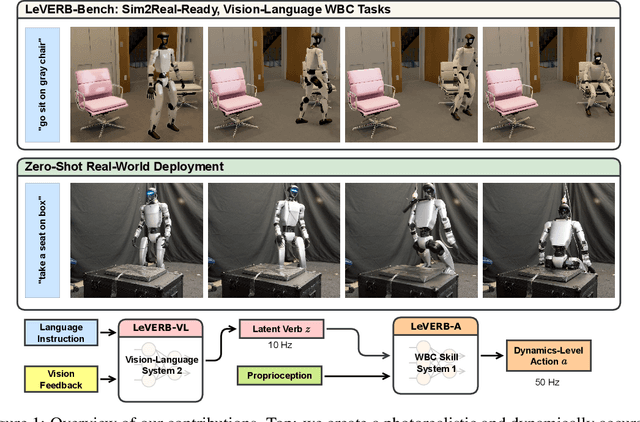
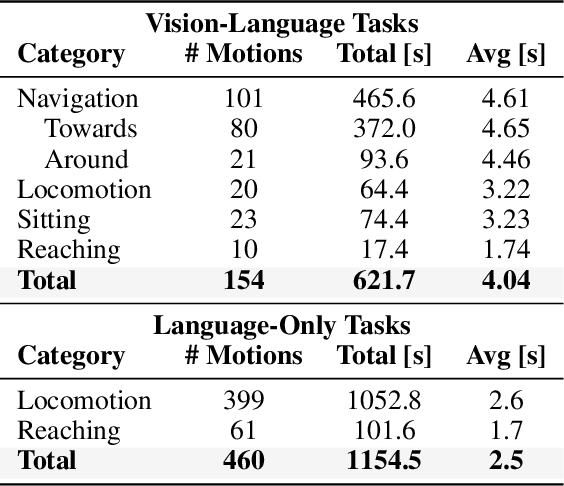
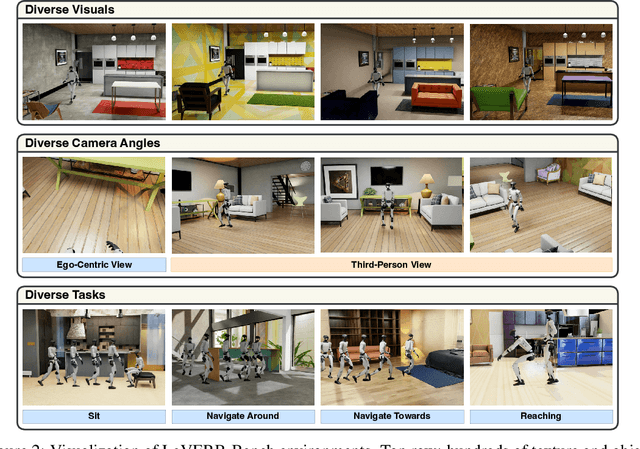
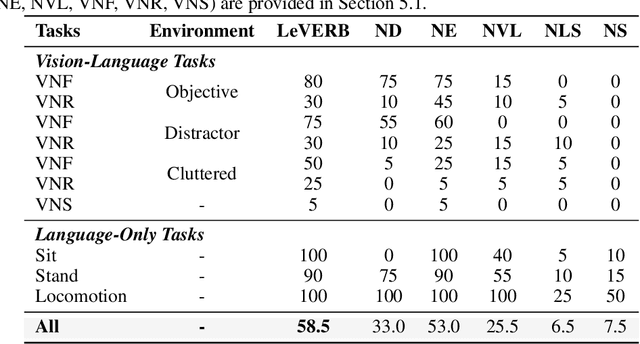
Abstract:Vision-language-action (VLA) models have demonstrated strong semantic understanding and zero-shot generalization, yet most existing systems assume an accurate low-level controller with hand-crafted action "vocabulary" such as end-effector pose or root velocity. This assumption confines prior work to quasi-static tasks and precludes the agile, whole-body behaviors required by humanoid whole-body control (WBC) tasks. To capture this gap in the literature, we start by introducing the first sim-to-real-ready, vision-language, closed-loop benchmark for humanoid WBC, comprising over 150 tasks from 10 categories. We then propose LeVERB: Latent Vision-Language-Encoded Robot Behavior, a hierarchical latent instruction-following framework for humanoid vision-language WBC, the first of its kind. At the top level, a vision-language policy learns a latent action vocabulary from synthetically rendered kinematic demonstrations; at the low level, a reinforcement-learned WBC policy consumes these latent verbs to generate dynamics-level commands. In our benchmark, LeVERB can zero-shot attain a 80% success rate on simple visual navigation tasks, and 58.5% success rate overall, outperforming naive hierarchical whole-body VLA implementation by 7.8 times.
Pre-training Auto-regressive Robotic Models with 4D Representations
Feb 18, 2025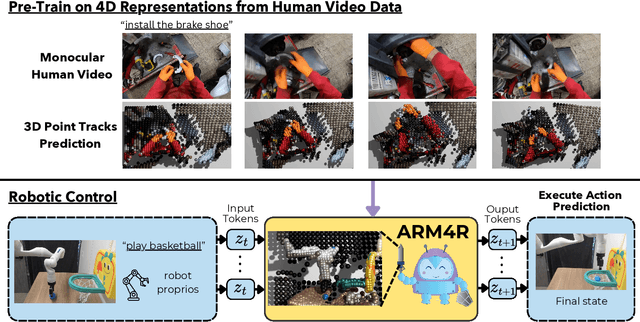

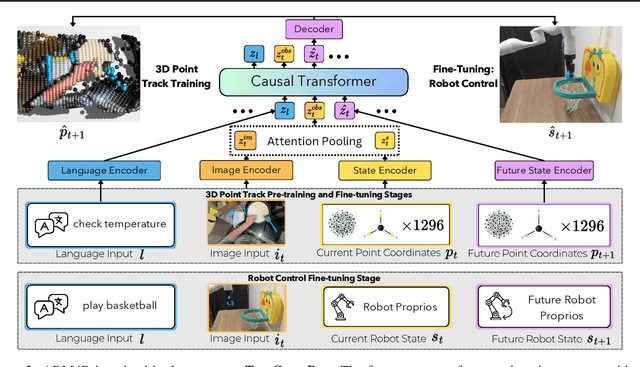

Abstract:Foundation models pre-trained on massive unlabeled datasets have revolutionized natural language and computer vision, exhibiting remarkable generalization capabilities, thus highlighting the importance of pre-training. Yet, efforts in robotics have struggled to achieve similar success, limited by either the need for costly robotic annotations or the lack of representations that effectively model the physical world. In this paper, we introduce ARM4R, an Auto-regressive Robotic Model that leverages low-level 4D Representations learned from human video data to yield a better pre-trained robotic model. Specifically, we focus on utilizing 3D point tracking representations from videos derived by lifting 2D representations into 3D space via monocular depth estimation across time. These 4D representations maintain a shared geometric structure between the points and robot state representations up to a linear transformation, enabling efficient transfer learning from human video data to low-level robotic control. Our experiments show that ARM4R can transfer efficiently from human video data to robotics and consistently improves performance on tasks across various robot environments and configurations.
In-Context Learning Enables Robot Action Prediction in LLMs
Oct 16, 2024Abstract:Recently, Large Language Models (LLMs) have achieved remarkable success using in-context learning (ICL) in the language domain. However, leveraging the ICL capabilities within LLMs to directly predict robot actions remains largely unexplored. In this paper, we introduce RoboPrompt, a framework that enables off-the-shelf text-only LLMs to directly predict robot actions through ICL without training. Our approach first heuristically identifies keyframes that capture important moments from an episode. Next, we extract end-effector actions from these keyframes as well as the estimated initial object poses, and both are converted into textual descriptions. Finally, we construct a structured template to form ICL demonstrations from these textual descriptions and a task instruction. This enables an LLM to directly predict robot actions at test time. Through extensive experiments and analysis, RoboPrompt shows stronger performance over zero-shot and ICL baselines in simulated and real-world settings.
Open-Vocabulary Audio-Visual Semantic Segmentation
Jul 31, 2024



Abstract:Audio-visual semantic segmentation (AVSS) aims to segment and classify sounding objects in videos with acoustic cues. However, most approaches operate on the close-set assumption and only identify pre-defined categories from training data, lacking the generalization ability to detect novel categories in practical applications. In this paper, we introduce a new task: open-vocabulary audio-visual semantic segmentation, extending AVSS task to open-world scenarios beyond the annotated label space. This is a more challenging task that requires recognizing all categories, even those that have never been seen nor heard during training. Moreover, we propose the first open-vocabulary AVSS framework, OV-AVSS, which mainly consists of two parts: 1) a universal sound source localization module to perform audio-visual fusion and locate all potential sounding objects and 2) an open-vocabulary classification module to predict categories with the help of the prior knowledge from large-scale pre-trained vision-language models. To properly evaluate the open-vocabulary AVSS, we split zero-shot training and testing subsets based on the AVSBench-semantic benchmark, namely AVSBench-OV. Extensive experiments demonstrate the strong segmentation and zero-shot generalization ability of our model on all categories. On the AVSBench-OV dataset, OV-AVSS achieves 55.43% mIoU on base categories and 29.14% mIoU on novel categories, exceeding the state-of-the-art zero-shot method by 41.88%/20.61% and open-vocabulary method by 10.2%/11.6%. The code is available at https://github.com/ruohaoguo/ovavss.
LLARVA: Vision-Action Instruction Tuning Enhances Robot Learning
Jun 17, 2024



Abstract:In recent years, instruction-tuned Large Multimodal Models (LMMs) have been successful at several tasks, including image captioning and visual question answering; yet leveraging these models remains an open question for robotics. Prior LMMs for robotics applications have been extensively trained on language and action data, but their ability to generalize in different settings has often been less than desired. To address this, we introduce LLARVA, a model trained with a novel instruction tuning method that leverages structured prompts to unify a range of robotic learning tasks, scenarios, and environments. Additionally, we show that predicting intermediate 2-D representations, which we refer to as "visual traces", can help further align vision and action spaces for robot learning. We generate 8.5M image-visual trace pairs from the Open X-Embodiment dataset in order to pre-train our model, and we evaluate on 12 different tasks in the RLBench simulator as well as a physical Franka Emika Panda 7-DoF robot. Our experiments yield strong performance, demonstrating that LLARVA - using 2-D and language representations - performs well compared to several contemporary baselines, and can generalize across various robot environments and configurations.
Unsupervised Universal Image Segmentation
Dec 28, 2023



Abstract:Several unsupervised image segmentation approaches have been proposed which eliminate the need for dense manually-annotated segmentation masks; current models separately handle either semantic segmentation (e.g., STEGO) or class-agnostic instance segmentation (e.g., CutLER), but not both (i.e., panoptic segmentation). We propose an Unsupervised Universal Segmentation model (U2Seg) adept at performing various image segmentation tasks -- instance, semantic and panoptic -- using a novel unified framework. U2Seg generates pseudo semantic labels for these segmentation tasks via leveraging self-supervised models followed by clustering; each cluster represents different semantic and/or instance membership of pixels. We then self-train the model on these pseudo semantic labels, yielding substantial performance gains over specialized methods tailored to each task: a +2.6 AP$^{\text{box}}$ boost vs. CutLER in unsupervised instance segmentation on COCO and a +7.0 PixelAcc increase (vs. STEGO) in unsupervised semantic segmentation on COCOStuff. Moreover, our method sets up a new baseline for unsupervised panoptic segmentation, which has not been previously explored. U2Seg is also a strong pretrained model for few-shot segmentation, surpassing CutLER by +5.0 AP$^{\text{mask}}$ when trained on a low-data regime, e.g., only 1% COCO labels. We hope our simple yet effective method can inspire more research on unsupervised universal image segmentation.
Object-based (yet Class-agnostic) Video Domain Adaptation
Nov 29, 2023



Abstract:Existing video-based action recognition systems typically require dense annotation and struggle in environments when there is significant distribution shift relative to the training data. Current methods for video domain adaptation typically fine-tune the model using fully annotated data on a subset of target domain data or align the representation of the two domains using bootstrapping or adversarial learning. Inspired by the pivotal role of objects in recent supervised object-centric action recognition models, we present Object-based (yet Class-agnostic) Video Domain Adaptation (ODAPT), a simple yet effective framework for adapting the existing action recognition systems to new domains by utilizing a sparse set of frames with class-agnostic object annotations in a target domain. Our model achieves a +6.5 increase when adapting across kitchens in Epic-Kitchens and a +3.1 increase adapting between Epic-Kitchens and the EGTEA dataset. ODAPT is a general framework that can also be combined with previous unsupervised methods, offering a +5.0 boost when combined with the self-supervised multi-modal method MMSADA and a +1.7 boost when added to the adversarial-based method TA$^3$N on Epic-Kitchens.
Audio-Visual Instance Segmentation
Oct 28, 2023



Abstract:In this paper, we propose a new multi-modal task, namely audio-visual instance segmentation (AVIS), in which the goal is to identify, segment, and track individual sounding object instances in audible videos, simultaneously. To our knowledge, it is the first time that instance segmentation has been extended into the audio-visual domain. To better facilitate this research, we construct the first audio-visual instance segmentation benchmark (AVISeg). Specifically, AVISeg consists of 1,258 videos with an average duration of 62.6 seconds from YouTube and public audio-visual datasets, where 117 videos have been annotated by using an interactive semi-automatic labeling tool based on the Segment Anything Model (SAM). In addition, we present a simple baseline model for the AVIS task. Our new model introduces an audio branch and a cross-modal fusion module to Mask2Former to locate all sounding objects. Finally, we evaluate the proposed method using two backbones on AVISeg. We believe that AVIS will inspire the community towards a more comprehensive multi-modal understanding.
Moiré Attack : A New Potential Risk of Screen Photos
Oct 20, 2021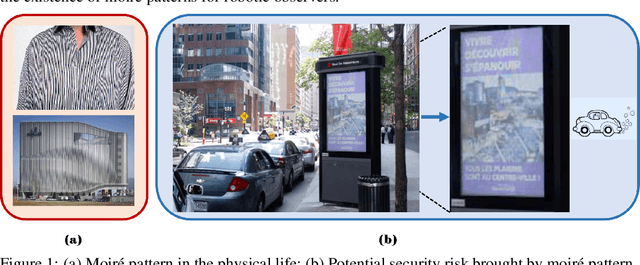


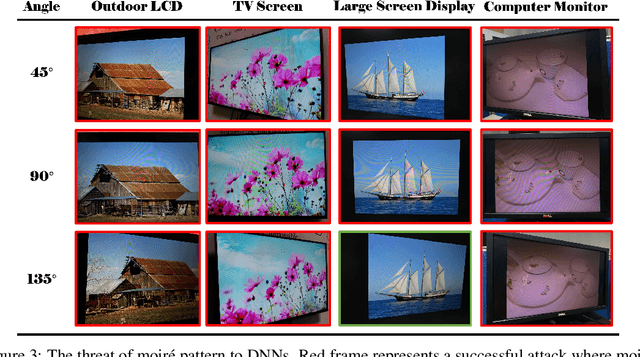
Abstract:Images, captured by a camera, play a critical role in training Deep Neural Networks (DNNs). Usually, we assume the images acquired by cameras are consistent with the ones perceived by human eyes. However, due to the different physical mechanisms between human-vision and computer-vision systems, the final perceived images could be very different in some cases, for example shooting on digital monitors. In this paper, we find a special phenomenon in digital image processing, the moir\'e effect, that could cause unnoticed security threats to DNNs. Based on it, we propose a Moir\'e Attack (MA) that generates the physical-world moir\'e pattern adding to the images by mimicking the shooting process of digital devices. Extensive experiments demonstrate that our proposed digital Moir\'e Attack (MA) is a perfect camouflage for attackers to tamper with DNNs with a high success rate ($100.0\%$ for untargeted and $97.0\%$ for targeted attack with the noise budget $\epsilon=4$), high transferability rate across different models, and high robustness under various defenses. Furthermore, MA owns great stealthiness because the moir\'e effect is unavoidable due to the camera's inner physical structure, which therefore hardly attracts the awareness of humans. Our code is available at https://github.com/Dantong88/Moire_Attack.
AdvDrop: Adversarial Attack to DNNs by Dropping Information
Aug 20, 2021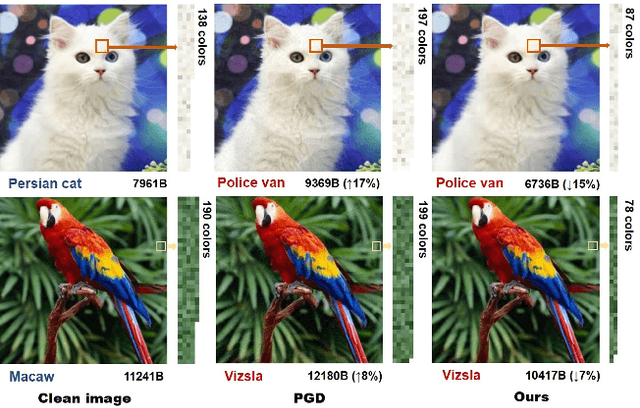

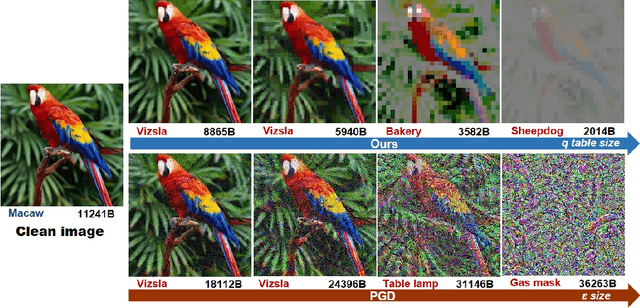
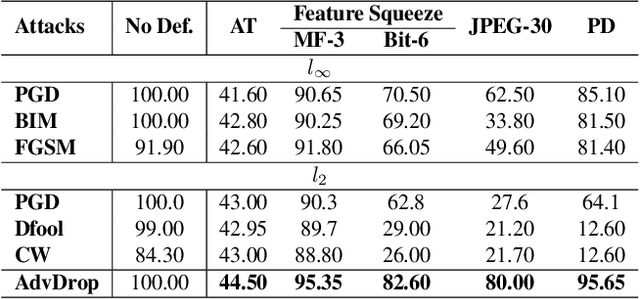
Abstract:Human can easily recognize visual objects with lost information: even losing most details with only contour reserved, e.g. cartoon. However, in terms of visual perception of Deep Neural Networks (DNNs), the ability for recognizing abstract objects (visual objects with lost information) is still a challenge. In this work, we investigate this issue from an adversarial viewpoint: will the performance of DNNs decrease even for the images only losing a little information? Towards this end, we propose a novel adversarial attack, named \textit{AdvDrop}, which crafts adversarial examples by dropping existing information of images. Previously, most adversarial attacks add extra disturbing information on clean images explicitly. Opposite to previous works, our proposed work explores the adversarial robustness of DNN models in a novel perspective by dropping imperceptible details to craft adversarial examples. We demonstrate the effectiveness of \textit{AdvDrop} by extensive experiments, and show that this new type of adversarial examples is more difficult to be defended by current defense systems.
 Add to Chrome
Add to Chrome Add to Firefox
Add to Firefox Add to Edge
Add to Edge